英语八大时态
英语八大时态

八大时态一、一般现在时:1.概念:经常、反复发生的动作或行为及现在的某种状况。
2.时间状语: always, usually, often, sometimes, every week (day, year, month…), once a week, on Sundays,3.基本结构:动词原形(如主语为第三人称单数,动词上要加(e)S)4.否定形式:am/is/are+not;此时态的谓语动词若;为行为动词,则在其前加don't,如主语为第三人称单数,则用doesn't,同时还原行为动词。
4.一般疑问句:把be动词放于句首;用助动词do提问,如主语为第三人称单数,则用does,同时,还原行为动词。
5.例句:. It seldom snows here.He is always ready to help others.Action speaks louder than words.二、一般过去时:1.概念:过去某个时间里发生的动作或状态;过去习惯性、经常性的动作2.时间状语:ago, yesterday, the day before yesterday, last week(year, night, month…), in 1989, just now, at the age of 5, one day, long long ago, once upon a time, etc.3.基本结构:be动词;行为动词4.否定形式:was/were+not;在行为动词前加didn't,同时还原行为动词。
5.一般疑问句:was或were放于句首;用助动词do的过去式did 提问,同时还原行为动词。
6.例句:She often came to help us in those days.I didn't know you were so busy.三、现在进行时:1.概念:表示现阶段或说话时正在进行的动作及行为。
英语八大时态总结
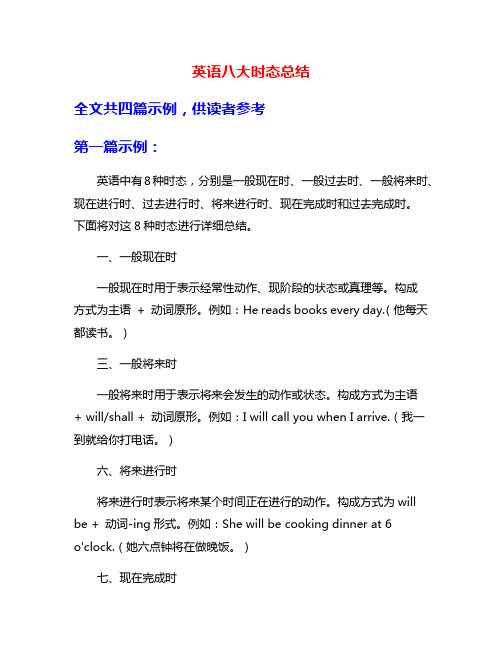
英语八大时态总结全文共四篇示例,供读者参考第一篇示例:英语中有8种时态,分别是一般现在时、一般过去时、一般将来时、现在进行时、过去进行时、将来进行时、现在完成时和过去完成时。
下面将对这8种时态进行详细总结。
一、一般现在时一般现在时用于表示经常性动作、现阶段的状态或真理等。
构成方式为主语+ 动词原形。
例如:He reads books every day.(他每天都读书。
)三、一般将来时一般将来时用于表示将来会发生的动作或状态。
构成方式为主语+ will/shall + 动词原形。
例如:I will call you when I arrive.(我一到就给你打电话。
)六、将来进行时将来进行时表示将来某个时间正在进行的动作。
构成方式为will be + 动词-ing形式。
例如:She will be cooking dinner at 6o'clock.(她六点钟将在做晚饭。
)七、现在完成时现在完成时用于表示过去某个时间开始的动作一直持续到现在,并可能继续发生。
构成方式为主语+ have/has + 过去分词。
例如:He has lived here for 5 years.(他在这里住了5年了。
)总结:1. 一般现在时表示经常性动作、现阶段的状态或真理。
2. 一般过去时表示过去某个时间发生的动作或状态。
3. 一般将来时表示将来会发生的动作或状态。
4. 现在进行时表示现在进行的动作或状态。
5. 过去进行时表示过去某个时间正在进行的动作。
6. 将来进行时表示将来某个时间将会进行的动作。
7. 现在完成时表示过去某个时间开始的动作一直持续到现在。
8. 过去完成时表示过去某个时间之前发生的动作。
掌握这8种时态的用法及构成方式对于学习英语语法和提高英语水平非常重要。
希望以上总结对您有所帮助。
第二篇示例:英语八大时态是学习英语语法非常重要的内容之一,掌握好各种时态的用法可以帮助我们更准确地表达自己的意思。
英语八大时态结构及用法
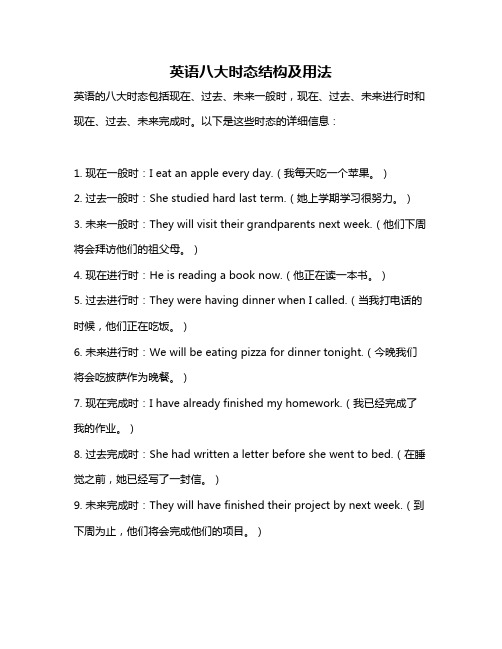
英语八大时态结构及用法
英语的八大时态包括现在、过去、未来一般时,现在、过去、未来进行时和现在、过去、未来完成时。
以下是这些时态的详细信息:
1. 现在一般时:I eat an apple every day.(我每天吃一个苹果。
)
2. 过去一般时:She studied hard last term.(她上学期学习很努力。
)
3. 未来一般时:They will visit their grandparents next week.(他们下周将会拜访他们的祖父母。
)
4. 现在进行时:He is reading a book now.(他正在读一本书。
)
5. 过去进行时:They were having dinner when I called.(当我打电话的时候,他们正在吃饭。
)
6. 未来进行时:We will be eating pizza for dinner tonight.(今晚我们将会吃披萨作为晚餐。
)
7. 现在完成时:I have already finished my homework.(我已经完成了我的作业。
)
8. 过去完成时:She had written a letter before she went to bed.(在睡觉之前,她已经写了一封信。
)
9. 未来完成时:They will have finished their project by next week.(到下周为止,他们将会完成他们的项目。
)
以上是英语八大时态的结构及用法,希望对你有所帮助。
英语常用八大时态

英语常用八大时态一、一般现在时:1. 时间状语:always, usually, often, sometimes其他:every day2. 基本结构: ①主语+be(am,is,are)+表语②主语+V.+宾语3. 否定形式:①主+am/is/are+ not+表语;②主+ don't / doesn't+ V 原形+宾语4. 一般疑问句:①把be动词放于句首②把do / does提到句首5. 例句:1) He is my good friend.He is not my good friend.Is he your good friend?Yes, he is. / No, he isn’t.Who is your good friend?2) She likes playing the piano.She doesn’t like playing the piano.Does she like playing the piano?Yes, she does. / No, s he doesn’t.What does she like doing?★第三人称单数,动词加s+s plays+es teaches去y+ ies studies二、现在进行时:1. 时间状语:now, at this time, these days其他:look / listen / 祈使句后面2. 基本结构:主+be(am/is/are)+doing3. 否定形式:主+be(am/is/are)+ not+ doing4. 一般疑问句:把be动词放于句首。
5. 例句:1)He is doing his homework.He is not doing his homework.Is he doing his homework?Yes, he is. / No, he isn’t.What is he doing?★动词加ing+ing playing去e+ing dancing双写+ing shopping三、一般过去时:1. 时间状语:ago, yesterday, last week, just now,this morning, the day before yesterday,in 1990, in the past2. 基本结构:①主+ be(was were)+表语②主语+V过去式+宾语3. 否定形式:①主+be(was/were)not+表语;②主+did not +V(原形)+表语4. 一般疑问句:① was were放于句首;② did用于句首,动词变回原形。
英语常用的八种语态

英语常用的八种语态
1. 一般现在时态 (Simple Present Tense)
主动语态:主语 + 动词原形
被动语态:主语 + am/is/are + 过去分词
2. 一般过去时态 (Simple Past Tense)
主动语态:主语 + 过去式
被动语态:主语 + was/were + 过去分词
3. 现在进行时态 (Present Continuous Tense) 主动语态:主语 + am/is/are + 现在分词
被动语态:主语 + am/is/are + being + 过去分词
4. 过去进行时态 (Past Continuous Tense)
主动语态:主语 + was/were + 现在分词
被动语态:主语 + was/were + being + 过去分词
5. 现在完成时态 (Present Perfect Tense)
主动语态:主语 + have/has + 过去分词
被动语态:主语 + have/has + been + 过去分词6. 过去完成时态 (Past Perfect Tense)
主动语态:主语 + had + 过去分词
被动语态:主语 + had + been + 过去分词
7. 将来时态 (Future Tense)
主动语态:主语 + will/shall + 动词原形
被动语态:主语 + will/shall + be + 过去分词
8. 将来完成时态 (Future Perfect Tense)
主动语态:主语 + will/shall + have + 过去分词
被动语态:主语 + will/shall + have + been + 过去分词。
英语语法的八大时态
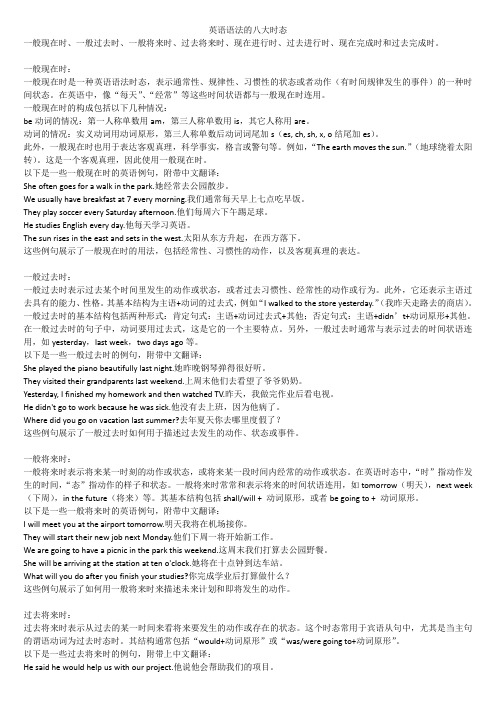
英语语法的八大时态一般现在时、一般过去时、一般将来时、过去将来时、现在进行时、过去进行时、现在完成时和过去完成时。
一般现在时:一般现在时是一种英语语法时态,表示通常性、规律性、习惯性的状态或者动作(有时间规律发生的事件)的一种时间状态。
在英语中,像“每天”、“经常”等这些时间状语都与一般现在时连用。
一般现在时的构成包括以下几种情况:be动词的情况:第一人称单数用am,第三人称单数用is,其它人称用are。
动词的情况:实义动词用动词原形,第三人称单数后动词词尾加s(es, ch, sh, x, o结尾加es)。
此外,一般现在时也用于表达客观真理,科学事实,格言或警句等。
例如,“The earth moves the sun.”(地球绕着太阳转)。
这是一个客观真理,因此使用一般现在时。
以下是一些一般现在时的英语例句,附带中文翻译:She often goes for a walk in the park.她经常去公园散步。
We usually have breakfast at 7 every morning.我们通常每天早上七点吃早饭。
They play soccer every Saturday afternoon.他们每周六下午踢足球。
He studies English every day.他每天学习英语。
The sun rises in the east and sets in the west.太阳从东方升起,在西方落下。
这些例句展示了一般现在时的用法,包括经常性、习惯性的动作,以及客观真理的表达。
一般过去时:一般过去时表示过去某个时间里发生的动作或状态,或者过去习惯性、经常性的动作或行为。
此外,它还表示主语过去具有的能力、性格。
其基本结构为主语+动词的过去式,例如“I walked to the store yesterday.”(我昨天走路去的商店)。
一般过去时的基本结构包括两种形式:肯定句式:主语+动词过去式+其他;否定句式:主语+didn’t+动词原形+其他。
英语八大时态总结表

英语八大时态总结表英语时态是英语语法的重要组成部分,对于英语学习者而言,掌握八大时态非常必要,因为它们能够帮助我们表达过去、现在和未来的情况和状态。
在本文中,我将为大家总结八大时态的构成、用法和例句,以便更好地理解和运用英语时态。
一、一般现在时态(Simple Present Tense)构成:主语 + 动词原形(动词第三人称单数加s或es)用法:表示客观事实、普遍真理、习惯或现在经常发生的动作、状态或感觉。
例句:1. I often play basketball on weekends.(我经常在周末打篮球。
)2. Water boils at 100 degrees Celsius.(水在100度时沸腾。
)3. He speaks English fluently.(他讲英语很流利。
)二、一般过去时态(Simple Past Tense)构成:主语 + 动词过去式用法:表示过去的动作、状态或事件,常常和一段明确的过去时间连用。
例句:1. I walked to school yesterday.(昨天我走路去学校了。
)2. He studied hard for the test last week.(上周他为考试努力学习。
)3. They didn't go to the party last night.(他们昨晚没有去聚会。
)三、一般将来时态(Simple Future Tense)构成:主语 + will + 动词原形用法:表示将来的动作、计划或意愿。
例句:1. I will take the bus to the airport tomorrow.(明天我会坐公交车去机场。
)2. He will graduate from college next year.(他明年会从大学毕业。
)3. They will have a meeting at 2 pm.(他们会在下午两点开会。
英语八大时态简明总结

英语八大时态简明总结一、一般现在时(Simple Present)描述经常性的动作或状态,或者客观事实例句:I eat breakfast every morning.(我每天早上吃早餐。
)二、一般过去时(Simple Past)描述过去发生的动作或状态例句:They studied English last night.(他们昨晚学了英语。
)三、一般将来时(Simple Future)描述将来发生的动作或状态例句:I will go to the store tomorrow.(我明天会去商店。
)四、现在进行时(Present Continuous)描述目前正在进行的动作例句:She is studying for her exam.(她正在为考试研究。
)五、过去进行时(Past Continuous)描述过去某个时间正在进行的动作例句:He was sleeping when I called.(我打电话的时候他正在睡觉。
)六、将来进行时(Future Continuous)描述将来某个时间会进行的动作例句:We will be traveling during the summer.(我们将在夏天期间旅行。
)七、现在完成时(Present Perfect)描述过去发生的动作对现在造成的影响例句:I have visited Paris before.(我以前去过巴黎。
)八、过去完成时(Past Perfect)描述过去某个时间或动作之前已经发生的动作例句:They had already left when I arrived.(当我到达时,他们已经离开了。
)。
英语八大时态总结表

英语八大时态总结表英语语态有八种:一般现在时、一般过去时、一般将来时、现在进行时、过去进行时、将来进行时、现在完成时和过去完成时。
一般现在时:表示经常、习惯性的动作或状态,或通常情况。
例句:I usually wake up at 6 o'clock in the morning.(我通常在早上6点醒来。
)一般过去时:表示过去某个时候发生的动作或状态。
例句:Yesterday, I went to the park with my friends.(昨天,我和我的朋友一起去了公园。
)一般将来时:表示将要发生的动作或状态。
例句:I will go to the concert tomorrow night.(我明晚将去听音乐会。
)现在进行时:表示正在进行的动作或状态。
例句:I am watching TV.(我正在看电视。
)过去进行时:表示在过去某个时间点正在进行的动作。
例句:At 8 o'clock last night, I was watching TV.(昨晚8点,我正在看电视。
)将来进行时:表示在将来某个时间点正在进行的动作。
例句:Tomorrow at 8 o'clock in the evening, Iwill be watching TV.(明天晚上8点,我将会正在看电视。
)现在完成时:表示过去某个时间点开始一直持续到现在的动作或状态。
例句:I have lived in this city for 5 years.(我已经在这个城市住了5年了。
)过去完成时:表示过去某个时间点之前已经完成的动作或状态。
例句:By the time I arrived, they had already left.(我到达的时候,他们已经离开了。
)以上八种语态使用灵活,掌握好各个语态的用法,能够更好地表达自己的意思。
英语中的八大时态

一般过去时:过去某个时间里发生的动作或状态;过去习 惯性、经常性的动作、行为。 时间状语:ago, yesterday, the day before yesterday, last
week(year, night, month…), in 1989, just now, at the age
of 5, one day, long long ago, once upon a time, etc. 基本结构:①be动词的过去式;②行为动词的过去式 否定形式:①was/were+not;②在行为动词前加didn't,同 时还原行为动词。 一般疑问句:①was或were放于句首;②用助动词do的过 去式did 提问,同时还原行为动词。
I didn't work hard at school.
We played basketball just now.
现在进行时:表示现阶段或说话时正在进行的动作及行为。
时间状语:now, at this time, these days, etc. 基本结构:am/is/are+doing 否定形式:am/is/are+not+doing. 一般疑问句:把be动词放于句首。 We are playing basketball now.
Байду номын сангаас
现在完成时:过去发生或已经完成的动作对现在造成的影响或结果,或从过去已 经开始,持续到现在的动作或状态。
时间状语:recently, lately, since…for…,in the past few years,already,before etc. 基本结构:have/has + done 否定形式:have/has + not +d one. 一般疑问句:have或has。 make friends with sb 和。。。交朋友 I have made friends with my new classmates already. He has worked in that hospital for 8 years. He worked in that hospital for 8 years. 过去完成时:以过去某个时间为标准,在此以前发生的动作或行为,或在过去某 动作之前完成的行为,即“过去的过去”。 时间状语:before, by the end of last year(term, month…),etc. 基本结构:had + done. 否定形式:had + not + done. 一般疑问句:had放于句首。 They had learned about eight hundred English words by the end of last term. The plane _(take off) when we got to the airport.
英语八大时态基本句型及例句

英语八大时态基本句型及例句英语中有八种基本时态,包括:现在简单时态、现在进行时态、现在完成时态、过去简单时态、过去进行时态、过去完成时态、将来简单时态和将来完成时态。
以下是每种时态的基本句型及例句:1. 现在简单时态(Present Simple Tense)基本句型:主语 + 动词原形(第三人称单数加s)例句:My sister reads books every day.(我姐姐每天都读书。
) 2. 现在进行时态(Present Continuous Tense)基本句型:主语 + am/is/are + 现在分词例句:I am studying English now.(我正在学英语。
)3. 现在完成时态(Present Perfect Tense)基本句型:主语 + have/has + 过去分词例句:She has visited many countries.(她去过很多国家。
) 4. 过去简单时态(Past Simple Tense)基本句型:主语 + 过去式动词例句:He went to the beach last weekend.(上周末他去了海滩。
)5. 过去进行时态(Past Continuous Tense)基本句型:主语 + was/were + 现在分词例句:They were playing basketball when it started to rain.(当下雨时他们正在打篮球。
)6. 过去完成时态(Past Perfect Tense)基本句型:主语 + had + 过去分词例句:I had finished my homework before my friends arrived.(朋友到达之前我已经完成了作业。
)7. 将来简单时态(Future Simple Tense)基本句型:主语 + will + 动词原形例句:I will help you with your project tomorrow.(我明天会帮你做项目。
英语八大时态
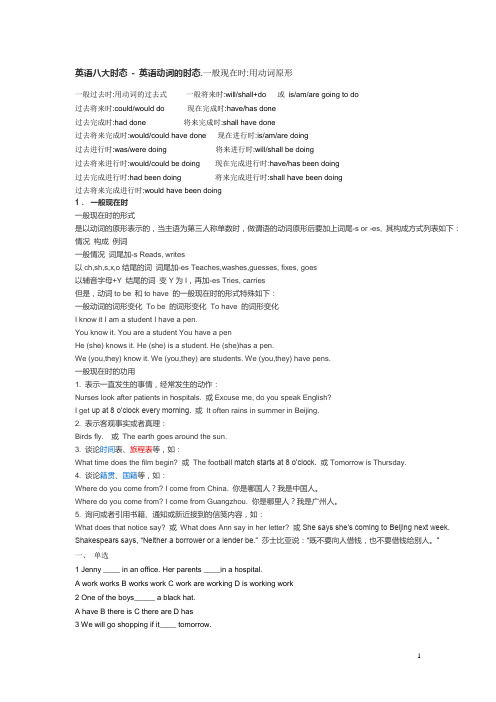
英语八大时态- 英语动词的时态.一般现在时:用动词原形一般过去时:用动词的过去式一般将来时:will/shall+do 或is/am/are going to do过去将来时:could/would do 现在完成时:have/has done过去完成时:had done 将来完成时:shall have done过去将来完成时:would/could have done 现在进行时:is/am/are doing过去进行时:was/were doing 将来进行时:will/shall be doing过去将来进行时:would/could be doing 现在完成进行时:have/has been doing过去完成进行时:had been doing 将来完成进行时:shall have been doing过去将来完成进行时:would have been doing1.一般现在时一般现在时的形式是以动词的原形表示的,当主语为第三人称单数时,做谓语的动词原形后要加上词尾-s or -es, 其构成方式列表如下:情况构成例词一般情况词尾加-s Reads, writes以ch,sh,s,x,o结尾的词词尾加-es Teaches,washes,guesses, fixes, goes以辅音字母+Y 结尾的词变Y为I,再加-es Tries, carries但是,动词to be 和to have 的一般现在时的形式特殊如下:一般动词的词形变化To be 的词形变化To have 的词形变化I know it I am a student I have a pen.You know it. You are a student You have a penHe (she) knows it. He (she) is a student. He (she)has a pen.We (you,they) know it. We (you,they) are students. We (you,they) have pens.一般现在时的功用1. 表示一直发生的事情,经常发生的动作:Nurses look after patients in hospitals. 或Excuse me, do you speak English?I get up at 8 o’clock every morning. 或It often rains in summer in Beijing.2. 表示客观事实或者真理:Birds fly. 或The earth goes around the sun.3. 谈论时间表、旅程表等,如:What time does the film begin? 或The footb all match starts at 8 o’clock. 或Tomorrow is Thursday.4. 谈论籍贯、国籍等,如:Where do you come from? I come from China. 你是哪国人?我是中国人。
英语八大时态标志词
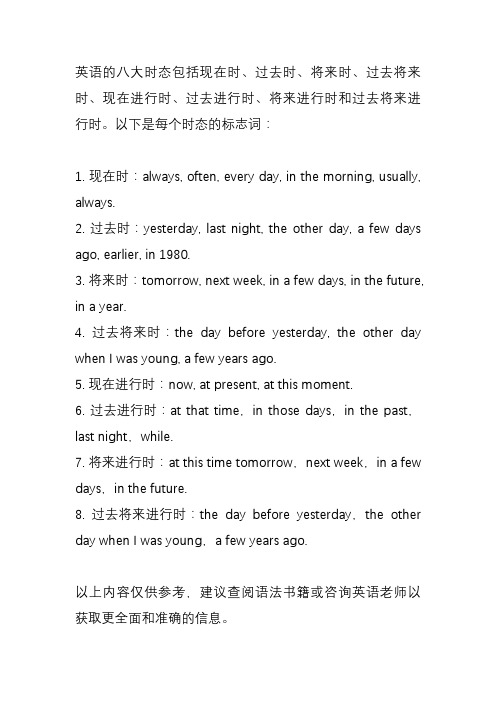
英语的八大时态包括现在时、过去时、将来时、过去将来时、现在进行时、过去进行时、将来进行时和过去将来进行时。
以下是每个时态的标志词:
1. 现在时:always, often, every day, in the morning, usually, always.
2. 过去时:yesterday, last night, the other day, a few days ago, earlier, in 1980.
3. 将来时:tomorrow, next week, in a few days, in the future, in a year.
4. 过去将来时:the day before yesterday, the other day when I was young, a few years ago.
5. 现在进行时:now, at present, at this moment.
6. 过去进行时:at that time,in those days,in the past,last night,while.
7. 将来进行时:at this time tomorrow,next week,in a few days,in the future.
8. 过去将来进行时:the day before yesterday,the other day when I was young,a few years ago.
以上内容仅供参考,建议查阅语法书籍或咨询英语老师以获取更全面和准确的信息。
英语八大时态要点总结
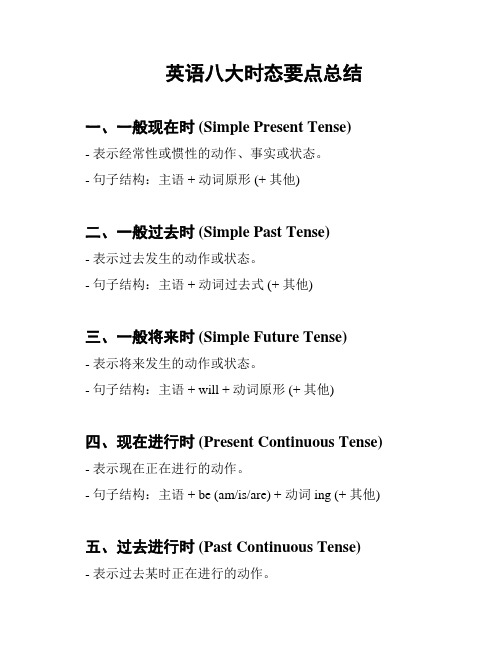
英语八大时态要点总结一、一般现在时 (Simple Present Tense)- 表示经常性或惯性的动作、事实或状态。
- 句子结构:主语 + 动词原形 (+ 其他)二、一般过去时 (Simple Past Tense)- 表示过去发生的动作或状态。
- 句子结构:主语 + 动词过去式 (+ 其他)三、一般将来时 (Simple Future Tense)- 表示将来发生的动作或状态。
- 句子结构:主语 + will + 动词原形 (+ 其他)四、现在进行时 (Present Continuous Tense) - 表示现在正在进行的动作。
- 句子结构:主语 + be (am/is/are) + 动词ing (+ 其他)五、过去进行时 (Past Continuous Tense)- 表示过去某时正在进行的动作。
- 句子结构:主语 + was/were + 动词ing (+ 其他)六、将来进行时 (Future Continuous Tense)- 表示将来某时正在进行的动作。
- 句子结构:主语 + will be + 动词ing (+ 其他)七、现在完成时 (Present Perfect Tense)- 表示过去某个时刻开始持续到现在,或者过去发生的动作对现在造成的影响。
- 句子结构:主语 + have/has + 过去分词 (+ 其他)八、过去完成时 (Past Perfect Tense)- 表示过去某个时间之前已经发生的动作。
- 句子结构:主语 + had + 过去分词 (+ 其他)以上为英语八大时态的要点总结,通过掌握这些时态的用法,可以更准确地描述不同的时间和动作。
在实际使用过程中,注意句子结构和动词形式的变化,以确保表达的准确性。
英语常用八大时态
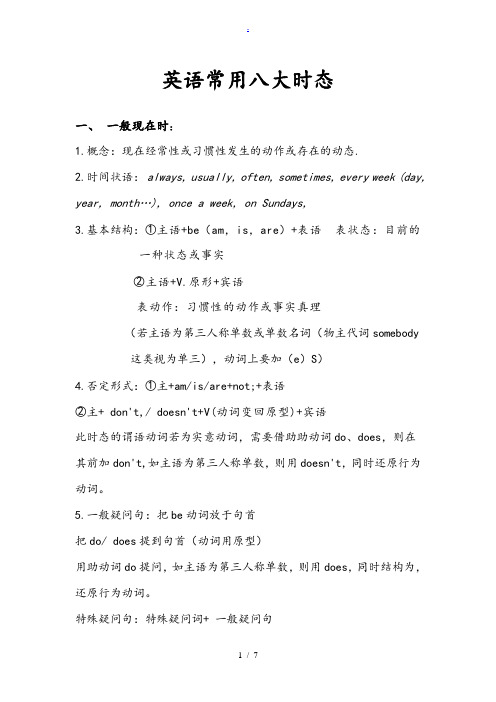
英语常用八大时态一、一般现在时:1.概念:现在经常性或习惯性发生的动作或存在的动态.2.时间状语: always, usually, often, sometimes, every week (day, year, month…), once a week, on Sundays,3.基本结构:○1主语+be(am,is,are)+表语表状态:目前的一种状态或事实○2主语+V.原形+宾语表动作:习惯性的动作或事实真理(若主语为第三人称单数或单数名词(物主代词somebody这类视为单三),动词上要加(e)S)4.否定形式:○1主+am/is/are+not;+表语○2主+ don't,/ doesn't+V(动词变回原型)+宾语此时态的谓语动词若为实意动词,需要借助助动词do、does,则在其前加don't,如主语为第三人称单数,则用doesn't,同时还原行为动词。
5.一般疑问句:把be动词放于句首把do/ does提到句首(动词用原型)用助动词do提问,如主语为第三人称单数,则用does,同时结构为,还原行为动词。
特殊疑问句:特殊疑问词+ 一般疑问句6.例句:. It seldom snows here.He is always ready to help others.Action speaks louder than words.二、一般过去时:1.概念:过去某个时间里发生的动作或状态;过去习惯性、经常性的动作、行为。
2.时间状语:ago, yesterday, the day before yesterday, last week(year, night, month…), in 1989, just now, at the age of 5, one day, long long ago, once upon a time, etc.3.基本结构:○1主+ be(was were)+其他(表示过去的状态或事实)。
英语语法八大时态总结建议收藏

英语语法八大时态总结,建议收藏!英语8大时态总结英语语法一直都是英语学习的一项重点和难点,而在这其中时态无疑是英语学习最重要的语法内容,学好时态基本就拿下了语法的半壁江山。
今天,帮大家总结的八种时态是大家在英语学习中必学必考的,复习时一定要加倍重视哦!一般现在时1.概念:经常、反复发生的动作或行为及现在的某种状况。
2.基本结构:①is/am/are;②do/does.否定形式:①am/is/are+not;②此时态的谓语动词若为行为动词,则在其前加don t,如主语为第三人称单数,则用doesn t,同时还原行为动词。
3.一般疑问句:①把is/am/are动词放于句首;②用助动词do提问,如主语为第三人称单数,则用does,同时,还原行为动词。
4.用法(1)经常性或习惯性的动作,常与表示频度的时间状语连用。
例如:I leave home for school at7every morning.每天早上我七点离开家。
(2)客观真理,客观存在,科学事实。
例如:The earth moves around the sun.地球绕太阳转动。
Shanghai lies in the east of China.上海位于中国东部。
(3)表示格言或警句。
例如:Pride goes before a fall.骄者必败。
注意:此用法如果出现在宾语从句中,即使主句是过去时,从句谓语也要用一般现在时。
例如:Columbus proved that the earth is round.哥伦布证实了地球是圆的。
(4)现在时刻的状态、能力、性格、个性。
例如:I don t want so much.我不要那么多。
Ann writes good English but does not speak well.安英语写得不错,讲的可不行。
(5)一般现在时表示将来含义a.下列动词come,go,arrive,leave,start,begin,return的一般现在时可以表示将来,主要用来表示在时间上已确定或安排好的事情。
英语8大时态表
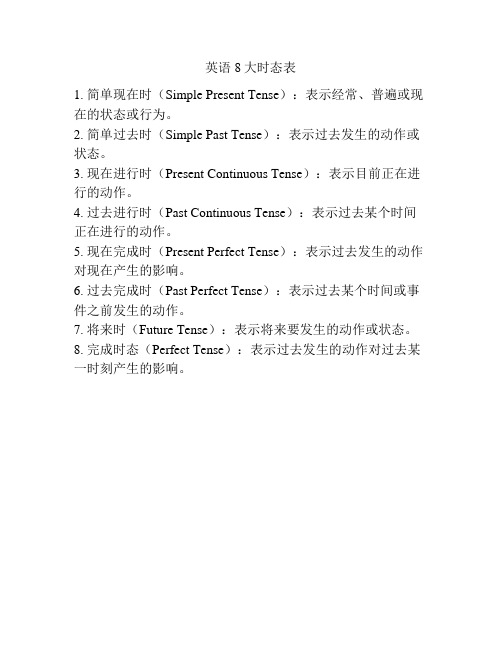
英语8大时态表
1. 简单现在时(Simple Present Tense):表示经常、普遍或现在的状态或行为。
2. 简单过去时(Simple Past Tense):表示过去发生的动作或状态。
3. 现在进行时(Present Continuous Tense):表示目前正在进行的动作。
4. 过去进行时(Past Continuous Tense):表示过去某个时间正在进行的动作。
5. 现在完成时(Present Perfect Tense):表示过去发生的动作对现在产生的影响。
6. 过去完成时(Past Perfect Tense):表示过去某个时间或事件之前发生的动作。
7. 将来时(Future Tense):表示将来要发生的动作或状态。
8. 完成时态(Perfect Tense):表示过去发生的动作对过去某一时刻产生的影响。
英语八大时态总结表
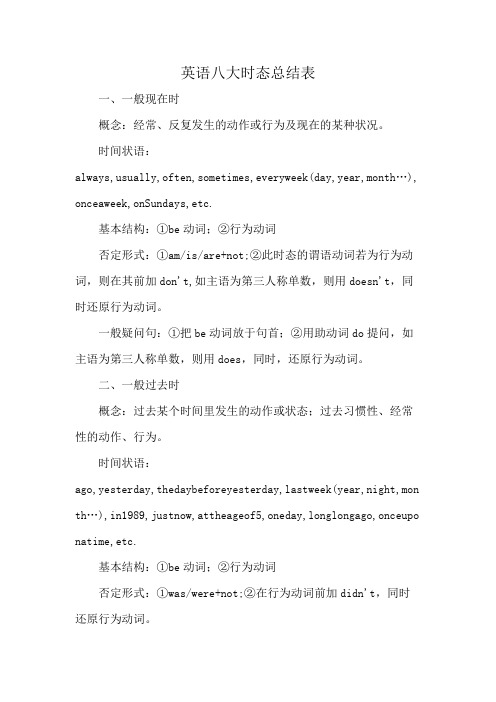
英语八大时态总结表一、一般现在时概念:经常、反复发生的动作或行为及现在的某种状况。
时间状语:always,usually,often,sometimes,everyweek(day,year,month…), onceaweek,onSundays,etc.基本结构:①be动词;②行为动词否定形式:①am/is/are+not;②此时态的谓语动词若为行为动词,则在其前加don't,如主语为第三人称单数,则用doesn't,同时还原行为动词。
一般疑问句:①把be动词放于句首;②用助动词do提问,如主语为第三人称单数,则用does,同时,还原行为动词。
二、一般过去时概念:过去某个时间里发生的动作或状态;过去习惯性、经常性的动作、行为。
时间状语:ago,yesterday,thedaybeforeyesterday,lastweek(year,night,mon th…),in1989,justnow,attheageof5,oneday,longlongago,onceupo natime,etc.基本结构:①be动词;②行为动词否定形式:①was/were+not;②在行为动词前加didn't,同时还原行为动词。
一般疑问句:①was或were放于句首;②用助动词do的过去式did提问,同时还原行为动词。
三、现在进行时概念:表示现阶段或说话时正在进行的动作及行为。
时间状语:now,atthistime,thesedays,etc.基本结构:am/is/are+doing否定形式:am/is/are+not+doing.一般疑问句:把be动词放于句首。
四、过去进行时概念:表示过去某段时间或某一时刻正在发生或进行的行为或动作。
时间状语:atthistimeyesterday,atthattime或以when引导的谓语动词是一般过去时的时间状语等。
基本结构:was/were+doing否定形式:was/were+not+doing.一般疑问句:把was或were放于句首。
英语八大时态标志词及结构表

英语八大时态标志词及结构表篇一:英语八大时态标志词及结构表正文:英语中存在八大时态,分别是:过去时、现在时、将来时、过去将来时、现在进行时、将来进行时、过去进行时、现在完成时和未来完成时。
这些时态的不同表达方式和用法,对于英语写作和口语表达都是非常重要的。
本文将介绍这些时态的标志词和结构表,帮助学习者更好地理解和掌握这些时态。
1. 过去时过去时通常用“态”或“ed”表示,表示动作或状态发生在过去。
标志词包括:- was(过去分词):表示动作或状态发生在过去某个时间。
- are(过去分词):表示动作或状态发生在过去。
- was/are(过去分词):表示动作或状态发生在过去的某个时刻。
结构表:| 主语 | 谓语动词 | 时态标志词 || --- | --- | --- || I | I was | was/are || you | you are | are || he/she/it | he/she/it was | was/are || we | we are | are || they | they were | were/are |2. 现在时现在时通常用“态”或“ing”表示,表示动作或状态现在正在进行。
标志词包括:- am/is(现在分词):表示动作或状态现在正在进行。
- are(现在分词):表示动作或状态现在正在进行。
- was/are(现在分词):表示动作或状态现在正在进行。
结构表:| 主语 | 谓语动词 | 时态标志词 || --- | --- | --- || I | I am | am/is || you | you are | are || he/she/it | he/she/it is | is/are || we | we are | are || they | they are | are |3. 将来时将来时通常用“态”或“ing”表示,表示动作或状态将来会发生。
标志词包括:- will(将来分词):表示动作或状态将来会发生。
- 1、下载文档前请自行甄别文档内容的完整性,平台不提供额外的编辑、内容补充、找答案等附加服务。
- 2、"仅部分预览"的文档,不可在线预览部分如存在完整性等问题,可反馈申请退款(可完整预览的文档不适用该条件!)。
- 3、如文档侵犯您的权益,请联系客服反馈,我们会尽快为您处理(人工客服工作时间:9:00-18:30)。
英语时态表
补充:
一、情态动词can, must, may。
may没有否定形式。
陈述句: I can drive a car. He must tell the truth. We may get there on foot.
否定句:I can’t swim at all. You mustn’t(表示禁止)smoke in the office.
一般疑问句: Can you wait a minute? Must I stay at home? May I use your phone?
特殊疑问句:How can I get there? What must I do now?
由情态动词的过去式构成,can—could.
She could walk when she was one year old.
I could not speak English one year ago.
二、各种时态用法补充:
1、一般现在时
(1)在由after, until, befor, once, when, even if ,in case, as long as, as soon as, the moment以及if, unless等引导的时间状语从句或条件状语从句中,通常用一般现在时代替将来时。
例:I will tell him the news as soon as I see him.
我一看见他,就把消息告诉他。
(2)某些表示起始的动词,可用一般现在时表示按规定、计划或安排要发生的动作,这类动词有:be, go, come, start, depart, arrive, begin, leave等。
(3)在由why, what, where, whoever, who, that,as等引导的从句中,也常用一般现在时代替将来时。
例:Tomorrow at this time we’ll give $500 to any one who brings him to justice.
2、一般将来时
(1)be going to +v在口语中广泛使用,表示准备做或即将发生的事情。
例:I’m going to buy a house when we’ve saved enough money.
(2)be to +v表示计划安排将要做的事。
例:There is to be a rail strike on July 18th.
(3)be about to+v表示即将发生的事情。
例:We are about to start.
(4)be due to+v表示预先确定了的、必定要发生的事。
例:His book is due to be published in October.
他的书预定10月份出版。
(5)be on the point/verge of +(v-ing)sth.强调即将发生的某种事态。
例:The country is on the verge of civil war.
这个国家就要打内战了。
3、现在进行时
(1)表示现阶段经常发生的动作,常与always, continually, constantly等连用(多表示赞扬或厌恶等语气)。
例:John is always coming late. 约翰总是迟到。
(2)表示根据计划或安排在最近要进行的事情。
具有这种语法功能的动词仅限于过渡性动词,即表示从一个状态或位置转移到另一个状态或位置上去的动词。
常用的有;go, come, leave, start, arrive,return等。
例:They are leaving for Hongkong next monty.
他们下个月去香港。
(3)有些动词一般不能使用进行时,这是一类表示“感觉”、“感情”、“存在”、“从属”等的动词。
如:see, hear, smell, taste, feel, notice, look, appear(表示感觉的动词);hate, love, fear, like, want,
wish, prefer, refuse, forgive(表示感情的动词);be, exist, remain, stay, obtain(表示存在状态的动词);have, possess, own, contain, belong, consist of , form(表示占有与从属的动词);understand, know, belive, think, doubt, forget, remember(表示思考、理解的动词)。
但是如果它们词义改变,有时也可使用进行时态。
例:Jane looks pale.What’s wrong with him?
珍妮看上去脸色苍白,她怎么了?(look在此为联系动词)
例:Jane is looking for his books.
珍妮正在寻找她的书。
(look在此为实义动词)
4.完成进行时
完成进行时是完成时的强调形式。
5.完成时态
(1)现在完成时与与一般过去时的区别:现在完成时强调过去发生的动作与现在的关系,如所发生的结果、影响等;而一般过去时只表示动作发生在过去表示某一时刻,不表示与现在的关系。
(2)完成时态可用在下列结构中:
This(That,It)is(was )the first(second….)time+定语从句:
This(That,It)is(was) the only (last)+名词+定语从句;
This(This,It)is (was)+形容词最高级+名词+定语从句。
如果主句的谓语动词是一般现在时,从句的谓语动词动词通常用现在完成时;
如果主句谓语动词是一般过去时,从句的谓语动词通常用过去完成时。
例1:This is the first time(that )I’ve drunk Californian champagne.
这是我第一次喝加利福尼亚香槟酒。
例2:There was a knock at the door.It was the second time someone had interrupted me that evening.
有人敲门,这是当天晚上第二次有人打扰我了。
6.动词expect, hope, mean, intend, plan, suppose, wish, want, desire等用过去完成时,表示过去的希望,预期,意图或愿望等没有实现。
例1:I had meant to leave to on Monday, but have stayed on.
我本来打算星期一离开,但最终还是继续留下来了。
另外两种表示“过去想做而未做的事”的表达方式是:
7.was / were+ to have done sth.
例1:We were to have come yesterday, but we couldn’t.
我们本想昨天来的,但我们来不了。
8.intended (expected, hoped, meant, planned, supposed, wished, wanted, desired)+ to have done sth.
例:1I mean to have told you about it, but I forgot to do so.
我本想告诉你这件事,但我忘掉了。
9.过去完成时常用于以下固定句型:
(1)hardly / scarcely / barely+过去完成时(倒装形式)+when +过去时
例1:Hardly had I arrived when I had a new problem to cope with.
我一到达就有新问题要处理。
(2) no sooner+过去完成时(倒装形式)+than +过去时。
例1:No sooner had the words been spoken than he realized that he should have remained silent.
这话刚说出口,他就意识到他本该保持沉默的。
(3)by(the end of )+过去时间,主句中谓语动词用过去完成时。
例1:By the end of that year Henry had collected more than a thousand foreign stamps. 到那年年底,亨利已收集了一千多张外国邮票
一、概况
二、十六种时态的谓语形势。
